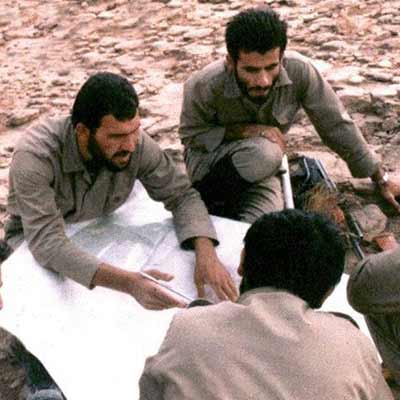Battles
Operation Valfajr 6
Masoumeh Sajadian
173 Views
The Islamic Revolutionary Guard Corps (IRGC) launched Operation Valfajr 6 in 1984 in Bostan and Dehloran.
On the eve of Operation Kheibar—which had been designed to disrupt the military equation of the war in favor of the Islamic Republic of Iran and help the Iranian units seize the initiative[1]—carrying out supportive and sometimes divisionary attacks were deemed necessary to increase its chances of success. Accordingly, the operational plan of the Valfajr 5 and Valfajr 6 were prepared.[2]
Operation Valfajr 5 was carried out on February 15, 1984, in Changooleh.[3] Operation Valfajr 6 took place on February 21, 1984, just hours before Operation Kheibar. Its primary objective was to destroy part of the enemy’s military forces and mislead them about the direction of the main offensive (Operation Kheibar).[4]
Three battalions—Tharallah (as), Abuzar, and Anbiya—of the IRGC 57th Hazrat Abalfazl (as) Brigade participated in the attack.[5]
The operation was planned to be launched on two fronts approximately 100 kilometers apart. The battlefield spanned from the Chilat region in Dehloran to Chazabeh in the Bostan front, as well as the al-Amarah Province of Iraq. The operation began at 11:30 PM with the code name “Ya Zahra (s)”. Supported by the artillery fire, the Iranian forces advanced into the highlands on the Dehloran front and after crossing the Chilat River, liberated two strategic heights overlooking the Iraqi city of Ali Gharbi thereby bringing the al-Amarah–Baghdad highway within range of their artillery fire.
After destroying Iraqi forces, Iranian combatants reached the Kalat Outpost, the Ali Gharbi border road, and a sand factory all of which were brought under direct Iranian observation and fire. In the Chazabeh Pass, the forces overcame minefields, barbed wire barriers, marshes, and sand dunes, and attacked Iraqi troops. They broke through the enemy’s defensive lines and by 1:30 AM had reached a front located along the Tayyeb–Chazabeh border road and a man-made canal that Iraq had constructed to impede Iranian advancement. As dawn broke, the battle turned into close-quarters combat. Iraq sought to halt the Iranian advance with constant artillery fire, which was countered by Iranian artillery and mortar units.[6]
According to captured Iraqi soldiers, the enemy was taken by surprise during Operation Valfajr 6 despite claims made by Baghdad’s military officials to the contrary.[7] Iranian forces advanced to within 17 kilometers of the Basra–Baghdad Highway, destroying Iraq’s 77th Brigade and two battalions of its 4th Army, and setting fire to numerous military vehicles, tanks, and personnel carriers.[8]
On Tuesday, foreign news agencies repeatedly reported that Iraqi officials had announced an imminent large-scale Iranian attack. However, Iraq could not prevent the defeat of its troops. The French press wrote, “Since the beginning of Iranian attacks in July 1982, this is the first time Iran is carrying out two simultaneous attacks”.
The American news agencies, United Press and Associated Press, also published several war reports highlighting the Iranian forces’ achievements. The United Press noted, “This Iranian attack has threatened the main network supplying route between Baghdad and Basra”.[9]
At 11:00 AM on February 23rd, the Iraqi army launched a counterattack and retook the area. In this counteroffensive, three battalion commanders and several members of the 57th Hazrat Abalfazl (as) Brigade were martyred, and their bodies remained on the battlefield.
On February 25th of the same year, two battalions consisting of the forces from Omidieh and Aghajari attacked the area again through the northern part of Chazabeh. However, this attack was unsuccessful, and they could not break through the enemy’s positions.[10] With the launch of the major Operation Kheibar in southern Iran, the units involved in Operation Valfajr 6 were deployed to the Kheibar battlefield.[11]
[1] Dorudian, Muhammad, Seyri dar Jang-e Iran va Araq, Vol. 2: Khorramshahr ta Faw (A Survey of the Iran-Iraq War, Vol. 2: From Khorramshahr to Faw), Tehran: Markaz-e Motaleat va Tahqiqat-e Jang, Fifth Edition, 1999, p. 81.
[2] Moradi Moqaddam, Morad; Ghasem, Nazari, Dehloran dar Ayeneh-ye Hasht Sal Defa Muqaddas (Dehloran in the Mirror of the Eight-Year Sacred Defense), Ilam: Barg-e Azin, 2011, p. 214.
[3] Alaie, Hussain, Ravand-e Jang-e Iran va Araq, Vol. 2 (The Course of the Iran-Iraq War, Vol. 2), Tehran: Marz-o-Boom, 2012, p. 41.
[4] Samiei, Ali, Karnama-ye Tawsifi-ye Amaliat-e Razmandegan-e Islam dar Hasht Sal-e Defa Muqaddas (Descriptive Record of Islamic Combatants’ Operations During the Eight-Year Sacred Defense), Tehran: Namayandegi-ye Vali-e Faqih dar Niroo-ye Zamini, Moavenat-e Tablighat va Entesharat, 1997, p. 165.
[5] Alaie, Hussain, Ravand-e Jang-e Iran va Araq (The Course of the Iran-Iraq War), Tehran, p. 44.
[6] Samiei, Ali, Karnama-ye Tawsifi-ye Amaliat-e Razmandegan-e Islam dar Hasht Sal-e Defa Muqaddas (Descriptive Record of Islamic Combatants’ Operations During the Eight-Year Sacred Defense), Pp. 165–166; Rouznameh-ye Jomhouri-ye Eslami (Jomhouri-ye Eslami Newspaper), No. 1375, Esfand 4, 1362, p. 2.
[7] Rouznameh-ye Jomhouri-ye Eslami (Jomhouri-ye Eslami Newspaper), ibid.
[8] Samiei, Ali, Karnama-ye Tawsifi-ye Amaliat-e Razmandegan-e Islam dar Hasht Sal-e Defa Muqaddas (Descriptive Record of Islamic Combatants' Operations During the Eight-Year Sacred Defense), p. 167; Rouznameh-ye Jomhouri-ye Eslami (Jomhouri-ye Eslami Newspaper), ibid.
[9] Rouznameh-ye Jomhouri-ye Eslami (Jomhouri-ye Eslami Newspaper), ibid., p. 14.
[10] Alaie, Hussain, Ravand-e Jang-e Iran va Araq (The Course of the Iran-Iraq War), p. 45.
[11] Moradi Muqaddam, Morad; Ghasem, Nazari, Dehloran dar Ayeneh-ye Hasht Sal Defa Muqaddas (Dehloran in the Mirror of the Eight-Year Sacred Defense), p. 215.





